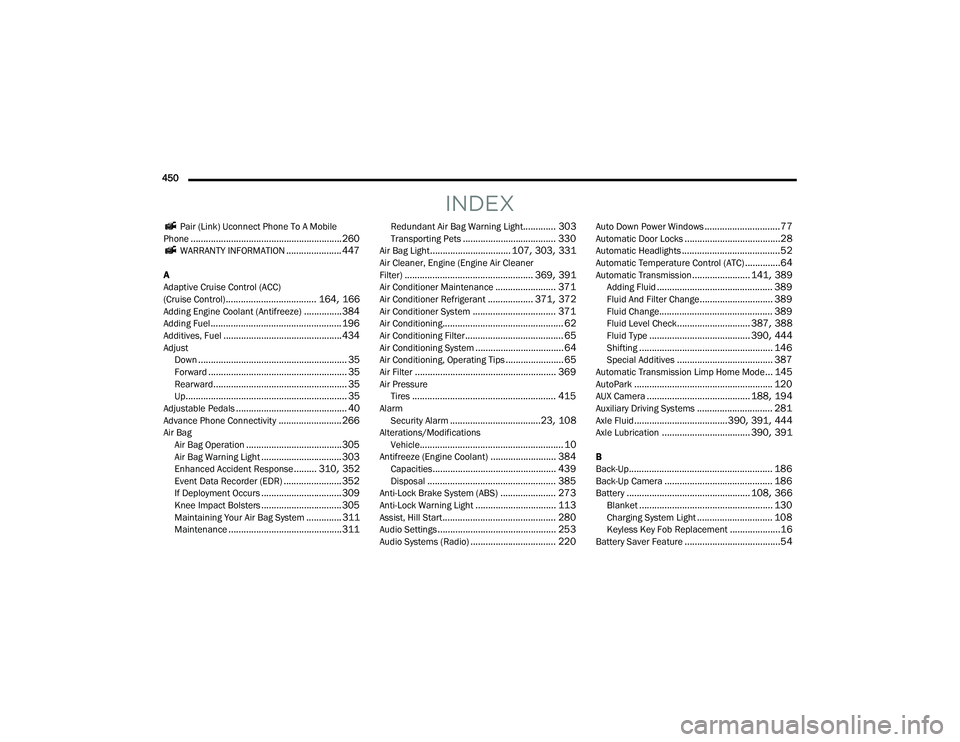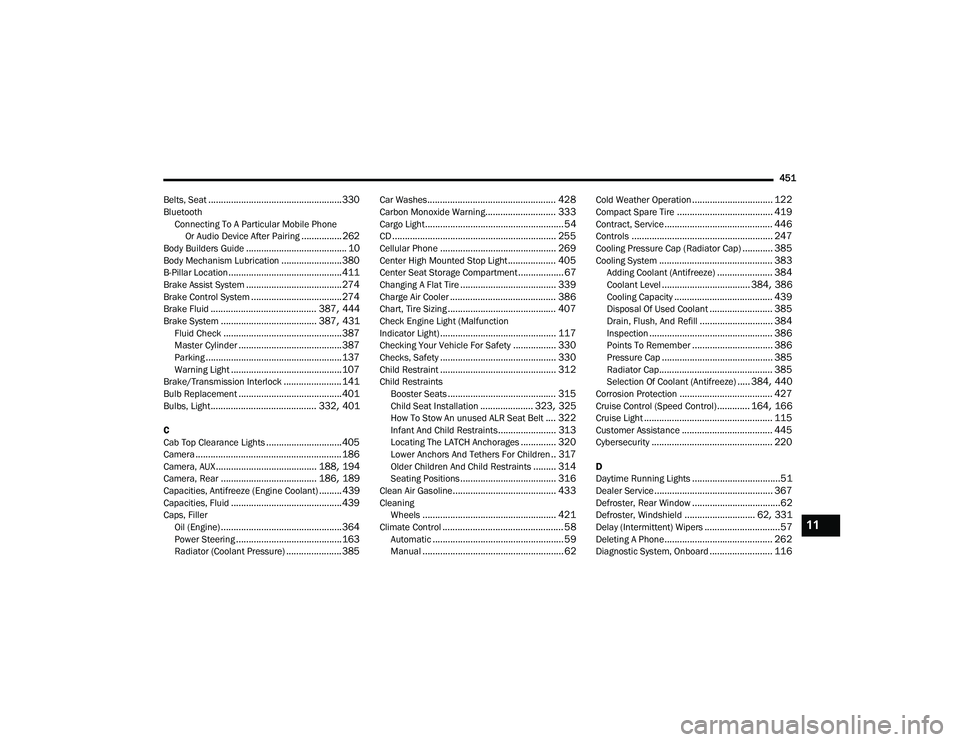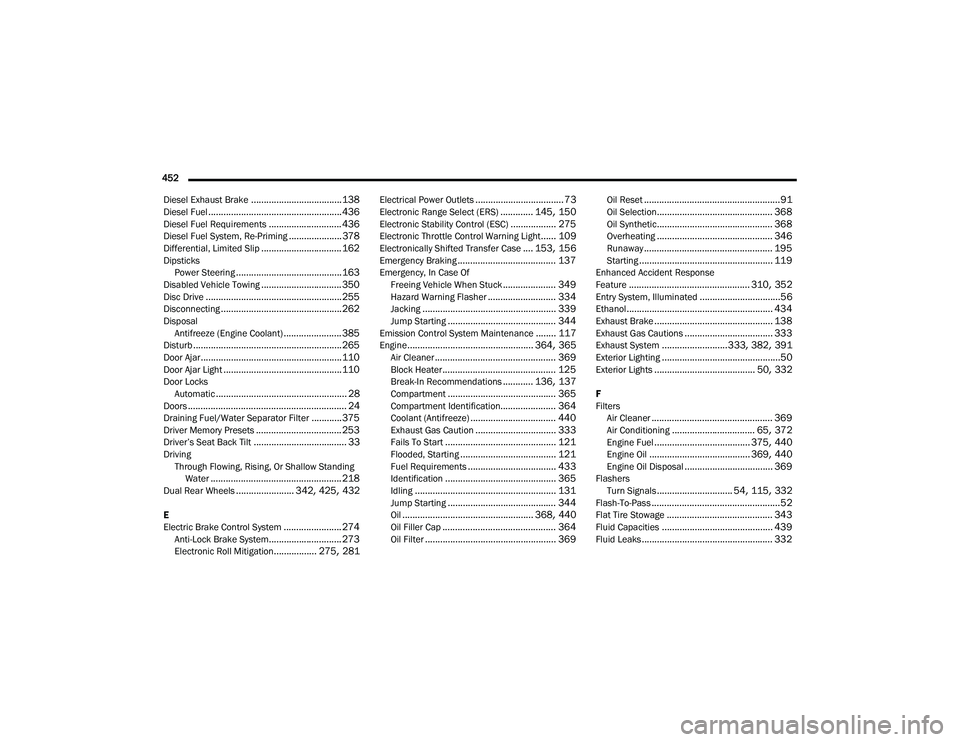engine coolant RAM CHASSIS CAB 2021 Owner's Guide
[x] Cancel search | Manufacturer: RAM, Model Year: 2021, Model line: CHASSIS CAB, Model: RAM CHASSIS CAB 2021Pages: 463, PDF Size: 21.5 MB
Page 387 of 463

SERVICING AND MAINTENANCE385
Please review these recommendations for
using Organic Additive Technology (OAT) engine
coolant that meets the requirements of FCA
Material Standard MS.90032. When adding
engine coolant:
We recommend using Mopar Antifreeze/
Coolant 10 Year/150,000 Mile (240,000 km)
Formula OAT that meets the requirements of
FCA Material Standard MS.90032.
Mix a minimum solution of 50% OAT engine
coolant that meets the requirements of FCA
Material Standard MS.90032 and distilled
water. Use higher concentrations (not to
exceed 70%) if temperatures below −34°F
(−37°C) are anticipated. Please contact an
authorized dealer for assistance.
Use only high purity water such as distilled or
deionized water when mixing the water/
engine coolant solution. The use of lower
quality water will reduce the amount of corro -
sion protection in the engine cooling system.
NOTE:
It is the owner's responsibility to maintain the
proper level of protection against freezing
according to the temperatures occurring in
the area where the vehicle is operated.
Some vehicles require special tools to add
coolant properly. Failure to fill these systems
properly could lead to severe internal engine
damage. If any coolant is needed to be added
to the system, please contact a local autho -
rized dealer.
Mixing engine coolant types is not recom -
mended and can result in cooling system
damage. If HOAT and OAT coolant are mixed
in an emergency, have an authorized dealer
drain, flush, and refill with OAT coolant
(conforming to MS.90032) as soon as
possible.
Cooling System Pressure Cap
The cap must be fully tightened to prevent loss
of engine coolant (antifreeze), and to ensure
that engine coolant will return to the radiator
from the coolant expansion bottle/recovery
tank (if equipped).
The cap should be inspected and cleaned if
there is any accumulation of foreign material on
the sealing surfaces.Disposal Of Used Coolant
Used ethylene glycol-based coolant (antifreeze)
is a regulated substance requiring proper
disposal. Check with your local authorities
to determine the disposal rules for your
community. To prevent ingestion by animals or
children, do not store ethylene glycol-based
coolant in open containers or allow it to remain
in puddles on the ground, clean up any ground
spills immediately. If ingested by a child or pet,
seek emergency assistance immediately.
WARNING!
Do not open hot engine cooling system.
Never add engine coolant (antifreeze) when
the engine is overheated. Do not loosen or
remove the cap to cool an overheated
engine. Heat causes pressure to build up in
the cooling system. To prevent scalding or
injury, do not remove the pressure cap
while the system is hot or under pressure.
Do not use a pressure cap other than the
one specified for your vehicle. Personal
injury or engine damage may result.
8
21_DPF_OM_EN_USC_t.book Page 385
Page 388 of 463

386SERVICING AND MAINTENANCE
Checking Coolant Level — 6.4L Engine
The level of the coolant in the pressurized
coolant bottle should be between the “MIN” and
“MAX” range on the bottle when the engine is
cold.
The radiator normally remains completely full,
so there is no need to remove the cap unless
checking for coolant freeze point or replacing
engine coolant (antifreeze). Advise your service
attendant of this. As long as the engine operating
temperature is satisfactory, the coolant bottle
need only be checked once a month. When
additional engine coolant is needed to maintain
the proper level, it should be added to the coolant
bottle. Do not overfill.
Cooling System Notes
NOTE:
When the vehicle is stopped after a few miles/
kilometers of operation, you may observe vapor
coming from the front of the engine compart -
ment. This is normally a result of moisture from
rain, snow, or high humidity accumulating on
the radiator and being vaporized when the ther -
mostat opens, allowing hot engine coolant (anti -
freeze) to enter the radiator. If an examination of your engine compartment
shows no evidence of radiator or hose leaks,
the vehicle may be safely driven. The vapor will
soon dissipate.
Do not overfill the coolant expansion bottle.
Check the coolant freeze point in the radiator
and in the coolant expansion bottle. If engine
coolant (antifreeze) needs to be added, the
contents of the coolant expansion bottle
must also be protected against freezing.
If frequent engine coolant additions are
required, the cooling system should be pres
-
sure tested for leaks.
Maintain engine coolant concentration at a
minimum of 50% OAT coolant (conforming to
MS.90032) and distilled water for proper
corrosion protection of your engine which
contains aluminum components.
Make sure that the coolant expansion bottle
overflow hoses are not kinked or obstructed.
Keep the front of the radiator clean. If your
vehicle is equipped with air conditioning,
keep the front of the condenser clean.
Do not change the thermostat for Summer or
Winter operation. If replacement is ever
necessary, install ONLY the correct type ther -
mostat. Other designs may result in unsatis -
factory engine cooling performance, poor gas
mileage, and increased emissions.
CHARGE AIR COOLER — INTER-COOLER
The charge air cooler is positioned below the
radiator and the air conditioner condenser. Air
enters the engine through the air cleaner and
passes through the turbocharger, where it is
pressurized. This pressurized air rapidly reaches
high temperature. The air is then directed
through a hose to the charge air cooler and
through another hose to the intake manifold of
the engine. The air entering the engine has been
cooled by about 50° to 100°F (10° to 38°C).
This cooling process enables more efficient
burning of fuel resulting in fewer emissions.
To guarantee optimum performance of the
system, keep the surfaces of the charge air
cooler, condenser and radiator clean and free
of debris. Periodically check the hoses leading
to and from the charge air cooler for cracks or
loose clamps resulting in loss of pressure and
reduced engine performance.
21_DPF_OM_EN_USC_t.book Page 386
Page 442 of 463

440TECHNICAL SPECIFICATIONS
ENGINE FLUIDS AND LUBRICANTS
6.4L GASOLINE ENGINE
Cooling System
6.7L Engine Chassis Cab 3500/4500 with AS69RC 22.3 Quarts21.1 Liters
6.7L Engine Chassis Cab 5500 with AS69RC 22.8 Quarts21.6 Liters
USMetric
Component Fluid, Lubricant, or Genuine Part
Engine CoolantWe recommend you use Mopar Antifreeze/Coolant 10–Year/150,000 Mile (240,000 km)
Formula OAT (Organic Additive Technology).
Engine Oil – 6.4L Engine For best performance and maximum protection under all types of operating conditions, the
manufacturer only recommends full synthetic engine oils that meet the American Petroleum
Institute (API) categories of SN. The manufacturer recommends the use of Pennzoil Ultra
0W-40 or equivalent Mopar engine oil meeting the requirements of FCA Material Standard
MS-12633 for use in all operating temperatures.
Engine Oil Filter – 6.4L Engine We recommend you use a Mopar Engine Oil Filter. If a Mopar Engine Oil Filter is unavailable
only use filters that meet or exceed SAE/USCAR-36 Filter Performance Requirements.
Fuel Selection – 6.4L Engine 87 Octane (R+M)/2 Method, 0-15% Ethanol (Do not use E-85).
21_DPF_OM_EN_USC_t.book Page 440
Page 443 of 463

TECHNICAL SPECIFICATIONS441
6.7L DIESEL ENGINE
Component Fluid, Lubricant, or Genuine Part
Engine CoolantWe recommend you use Mopar Antifreeze/Coolant 10 Year/150,000 Mile (240,000 km)
Formula OAT (Organic Additive Technology).
Engine Oil In ambient temperatures above 0°F (-18°C), we recommend you use 10W-30 engine oil such
as Mopar, Shell Rotella and Shell Rimula that meets FCA Material Standard MS-10902 and the
API CK-4 engine oil category is required. Products meeting Cummins CES 20081 may also be
used. The identification of these engine oils is typically located on the back of the oil container.
In ambient temperatures below 0°F (-18°C), we recommend you use 5W-40
synthetic engine
oil such as Mopar, Shell Rotella and Shell Rimula that meets FCA Material Standard MS-10902
and the API CK-4 engine oil category is required.
Engine Oil Filter We recommend you use a Mopar Engine Oil Filter. If a Mopar Engine Oil Filter is unavailable
only use filters that meet or exceed SAE/USCAR-36 Filter Performance Requirements.
Fuel Filters We recommend you use Mopar Fuel Filter. Must meet 3 micron rating (engine mounted filter).
Must meet 5 micron rating (chassis mounted filter).
Using a fuel filter that does not meet the
manufacturer’s filtration and water separating requirements can severely impact fuel system
life and reliability.
Crankcase Ventilation Filter We recommend you use Mopar CCV Filter.
9
21_DPF_OM_EN_USC_t.book Page 441
Page 445 of 463

TECHNICAL SPECIFICATIONS443
(Continued)
CAUTION!
Mixing of engine coolant (antifreeze) other
than specified Organic Additive Technology
(OAT) engine coolant (antifreeze), may
result in engine damage and may decrease
corrosion protection. Organic Additive Tech -
nology (OAT) engine coolant is different and
should not be mixed with Hybrid Organic
Additive Technology (HOAT) engine coolant
(antifreeze) or any “globally compatible”
coolant (antifreeze). If a non-OAT engine
coolant (antifreeze) is introduced into the
cooling system in an emergency, the
cooling system will need to be drained,
flushed, and refilled with fresh OAT coolant
(conforming to MS.90032), by an autho -
rized dealer as soon as possible.Do not use water alone or alcohol-based
engine coolant (antifreeze) products. Do
not use additional rust inhibitors or antirust
products, as they may not be compatible
with the radiator engine coolant and may
plug the radiator.
This vehicle has not been designed for use
with propylene glycol-based engine coolant
(antifreeze). Use of propylene glycol-based
engine coolant (antifreeze) is not recom -
mended.
CAUTION! (Continued)
9
21_DPF_OM_EN_USC_t.book Page 443
Page 452 of 463

450
INDEX
Pair (Link) Uconnect Phone To A Mobile
Phone............................................................ 260 WARRANTY INFORMATION...................... 447
A
Adaptive Cruise Control (ACC)
(Cruise Control)
.................................... 164, 166Adding Engine Coolant (Antifreeze)............... 384Adding Fuel.................................................... 196Additives, Fuel............................................... 434Adjust Down........................................................... 35Forward....................................................... 35Rearward..................................................... 35Up................................................................ 35Adjustable Pedals............................................ 40Advance Phone Connectivity......................... 266Air BagAir Bag Operation...................................... 305Air Bag Warning Light................................ 303Enhanced Accident Response......... 310, 352Event Data Recorder (EDR)....................... 352If Deployment Occurs................................ 309Knee Impact Bolsters................................ 305Maintaining Your Air Bag System.............. 311Maintenance............................................. 311
Redundant Air Bag Warning Light............. 303Transporting Pets..................................... 330Air Bag Light................................ 107, 303, 331Air Cleaner, Engine (Engine Air Cleaner
Filter)................................................... 369, 391Air Conditioner Maintenance........................ 371Air Conditioner Refrigerant.................. 371, 372Air Conditioner System................................. 371Air Conditioning................................................ 62Air Conditioning Filter....................................... 65Air Conditioning System................................... 64Air Conditioning, Operating Tips....................... 65Air Filter........................................................ 369Air PressureTires......................................................... 415AlarmSecurity Alarm....................................23, 108Alterations/ModificationsVehicle......................................................... 10Antifreeze (Engine Coolant).......................... 384Capacities................................................. 439Disposal................................................... 385Anti-Lock Brake System (ABS)...................... 273Anti-Lock Warning Light................................ 113Assist, Hill Start............................................. 280Audio Settings............................................... 253Audio Systems (Radio).................................. 220
Auto Down Power Windows..............................77Automatic Door Locks......................................28Automatic Headlights.......................................52Automatic Temperature Control (ATC)..............64Automatic Transmission....................... 141, 389Adding Fluid.............................................. 389Fluid And Filter Change............................. 389Fluid Change............................................. 389Fluid Level Check............................. 387, 388Fluid Type........................................ 390, 444Shifting..................................................... 146Special Additives...................................... 387Automatic Transmission Limp Home Mode... 145AutoPark....................................................... 120AUX Camera......................................... 188, 194Auxiliary Driving Systems.............................. 281Axle Fluid.....................................390, 391, 444Axle Lubrication................................... 390, 391
B
Back-Up......................................................... 186Back-Up Camera........................................... 186Battery................................................. 108, 366Blanket..................................................... 130Charging System Light.............................. 108Keyless Key Fob Replacement....................16Battery Saver Feature......................................54
21_DPF_OM_EN_USC_t.book Page 450
Page 453 of 463

451
Belts, Seat
..................................................... 330Bluetooth Connecting To A Particular Mobile Phone Or Audio Device After Pairing
................262Body Builders Guide........................................ 10Body Mechanism Lubrication........................ 380B-Pillar Location............................................. 411Brake Assist System...................................... 274Brake Control System.................................... 274Brake Fluid.......................................... 387, 444Brake System...................................... 387, 431Fluid Check............................................... 387Master Cylinder......................................... 387Parking...................................................... 137Warning Light............................................ 107Brake/Transmission Interlock....................... 141Bulb Replacement......................................... 401Bulbs, Light.......................................... 332, 401
C
Cab Top Clearance Lights.............................. 405Camera.......................................................... 186Camera, AUX........................................ 188, 194Camera, Rear...................................... 186, 189Capacities, Antifreeze (Engine Coolant)......... 439Capacities, Fluid............................................ 439Caps, FillerOil (Engine)................................................ 364Power Steering.......................................... 163Radiator (Coolant Pressure)...................... 385
Car Washes................................................... 428Carbon Monoxide Warning............................ 333Cargo Light....................................................... 54CD................................................................. 255Cellular Phone.............................................. 269Center High Mounted Stop Light................... 405Center Seat Storage Compartment.................. 67Changing A Flat Tire...................................... 339Charge Air Cooler.......................................... 386Chart, Tire Sizing........................................... 407Check Engine Light (Malfunction
Indicator Light).............................................. 117Checking Your Vehicle For Safety................. 330Checks, Safety.............................................. 330Child Restraint.............................................. 312Child RestraintsBooster Seats........................................... 315Child Seat Installation..................... 323, 325How To Stow An unused ALR Seat Belt.... 322Infant And Child Restraints....................... 313Locating The LATCH Anchorages.............. 320Lower Anchors And Tethers For Children.. 317Older Children And Child Restraints......... 314Seating Positions...................................... 316Clean Air Gasoline......................................... 433CleaningWheels..................................................... 421Climate Control................................................ 58Automatic.................................................... 59Manual........................................................ 62
Cold Weather Operation................................ 122Compact Spare Tire...................................... 419Contract, Service........................................... 446Controls........................................................ 247Cooling Pressure Cap (Radiator Cap)............ 385Cooling System............................................. 383Adding Coolant (Antifreeze)...................... 384Coolant Level................................... 384, 386Cooling Capacity....................................... 439Disposal Of Used Coolant......................... 385Drain, Flush, And Refill............................. 384Inspection................................................. 386Points To Remember................................ 386Pressure Cap............................................ 385Radiator Cap............................................. 385Selection Of Coolant (Antifreeze)..... 384, 440Corrosion Protection..................................... 427Cruise Control (Speed Control)............. 164, 166Cruise Light................................................... 115Customer Assistance.................................... 445Cybersecurity................................................ 220
D
Daytime Running Lights...................................51Dealer Service............................................... 367Defroster, Rear Window...................................62Defroster, Windshield............................ 62, 331Delay (Intermittent) Wipers..............................57Deleting A Phone........................................... 262Diagnostic System, Onboard......................... 116
11
21_DPF_OM_EN_USC_t.book Page 451
Page 454 of 463

452 Diesel Exhaust Brake
.................................... 138Diesel Fuel..................................................... 436Diesel Fuel Requirements............................. 436Diesel Fuel System, Re-Priming..................... 378Differential, Limited Slip................................ 162Dipsticks Power Steering.......................................... 163Disabled Vehicle Towing................................ 350Disc Drive...................................................... 255Disconnecting................................................ 262DisposalAntifreeze (Engine Coolant)....................... 385Disturb........................................................... 265Door Ajar........................................................ 110Door Ajar Light............................................... 110Door LocksAutomatic.................................................... 28Doors............................................................... 24Draining Fuel/Water Separator Filter............ 375Driver Memory Presets.................................. 253Driver’s Seat Back Tilt..................................... 33DrivingThrough Flowing, Rising, Or Shallow Standing Water
.................................................... 218Dual Rear Wheels....................... 342, 425, 432
E
Electric Brake Control System....................... 274Anti-Lock Brake System............................. 273Electronic Roll Mitigation................. 275, 281
Electrical Power Outlets................................... 73Electronic Range Select (ERS)............. 145, 150Electronic Stability Control (ESC).................. 275Electronic Throttle Control Warning Light...... 109Electronically Shifted Transfer Case.... 153, 156Emergency Braking....................................... 137Emergency, In Case OfFreeing Vehicle When Stuck..................... 349Hazard Warning Flasher........................... 334Jacking..................................................... 339Jump Starting........................................... 344Emission Control System Maintenance........ 117Engine.................................................. 364, 365Air Cleaner................................................ 369Block Heater............................................. 125Break-In Recommendations............ 136, 137Compartment........................................... 365Compartment Identification...................... 364Coolant (Antifreeze).................................. 440Exhaust Gas Caution................................ 333Fails To Start............................................ 121Flooded, Starting...................................... 121Fuel Requirements................................... 433Identification............................................ 365Idling........................................................ 131Jump Starting........................................... 344Oil.................................................... 368, 440Oil Filler Cap............................................. 364Oil Filter.................................................... 369
Oil Reset......................................................91Oil Selection.............................................. 368Oil Synthetic.............................................. 368Overheating.............................................. 346Runaway................................................... 195Starting..................................................... 119Enhanced Accident Response
Feature................................................ 310, 352Entry System, Illuminated................................56Ethanol.......................................................... 434Exhaust Brake............................................... 138Exhaust Gas Cautions................................... 333Exhaust System..........................333, 382, 391Exterior Lighting...............................................50Exterior Lights........................................ 50, 332
F
FiltersAir Cleaner
................................................ 369Air Conditioning................................. 65, 372Engine Fuel...................................... 375, 440Engine Oil........................................ 369, 440Engine Oil Disposal................................... 369FlashersTurn Signals.............................. 54, 115, 332Flash-To-Pass...................................................52Flat Tire Stowage.......................................... 343Fluid Capacities............................................ 439Fluid Leaks.................................................... 332
21_DPF_OM_EN_USC_t.book Page 452